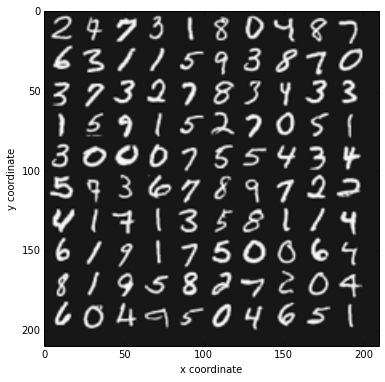the logistic Regression can only help resolve the problem of binary classification, what can we do when there are multiple different output labels?
There are 2 solutions:
- one-vs-all
- neural network
load the data and visualization
import the needed modules
#show the figures buildin the notebook
%matplotlib inline
import numpy as np
import matplotlib.pyplot as plt
import scipy.io #Used to load the OCTAVE *.mat files
import scipy.misc #Used to show matrix as an image
from scipy import optimize
import matplotlib.cm as cm #Used to display images in a specific colormap
import random
load the data from the file as matrix
fileName='ex3/data/ex3data1.mat'
samples = scipy.io.loadmat(fileName)
# extract to get (X,y) samples
X = samples['X']
X = np.insert(X,0,1,axis=1) # insert 1 before index 0 as a column
Y=samples['y']
# since the handy digit 0 is labeled as 10
Y=np.array([i % 10 for i in Y])
print "X's shape is: %s,X[0]'s shape is: %s" % (X.shape, X[0:1].shape)
print "y's shape is: %s, unique elements in y: %s" % (Y.shape, np.unique(Y))
X’s shape is: (5000, 401),X[0]’s shape is: (1, 401) y’s shape is: (5000, 1), unique elements in y: [0 1 2 3 4 5 6 7 8 9]
visualization the samples
def myPlotImg(myX):
xPixes, yPixes = (20,20)
nrows,ncols = (10,10)
pad = 1
# this variable is used to store all the 100 samples data which are used to visualize
big_pic = np.zeros((nrows * (xPixes + pad),ncols * (yPixes + pad)))
cr,cl=(0,0) #cr stands for rows, cl stands for column
for i in xrange(nrows):
for j in xrange(ncols):
# extract an sample as a 20 * 20 matrix
sample = myX[random.randint(1,X.shape[0])-1] #randomly get a sample
sample = sample[1:].reshape(xPixes,yPixes) # ignore the first column with value 1
big_pic[i * xPixes+pad:(i+1)*xPixes+pad,j*yPixes+pad:(j+1)*yPixes+pad] = sample.T
plt.figure(figsize=(6,6))
img = scipy.misc.toimage(big_pic)
plt.xlabel('x coordinate')
plt.ylabel('y coordinate')
plt.imshow(img,cmap=cm.Greys_r)
plt.show()
myPlotImg(X)

one-vs-all
For this solution, we make good use of logistic regression to complete this.
Mechnism
We take one label as the expected one(y=1) and the other labels are the negative labels(y=0)
implementation
implement cost and gradient function
# define the sigmoid function:
def sigmoid(z):
return 1.0 / (1.0 + np.exp(-z))
# define the cost function with regularization
def costFun(theta, myX, myY, mylambda = 0.0):
theta = theta.reshape(-1,1)
z = np.dot(X,theta)
T = sigmoid(z)
if np.isnan(T[0][0]):
print "there is nan value!!!!!!!!"
m = len(X)
result = np.sum(myY * np.log(T) + (1 - myY)*np.log(1-T)) * (-1) / m
theta2 = theta[1:,:]
result = result + (mylambda / (2* m)) * np.dot(theta2.T,theta2)
if np.isnan(result):
return np.inf
return result
# define the gradient function of cost function
def gradientFun(theta, myX, myY, mylambda =0.0):
theta = theta.reshape(-1,1)
# print theta, theta.shape
Z = np.dot(myX, theta) # m*1
T = sigmoid(Z)
m = len(myX)
result = np.dot(myX.T,T - myY) / m # n * 1
theta[0] = 0
result = result + (mylambda / m) * theta
return result.flatten()
def oneVSAll(myX, myY, mylambda=0.0):
# get all the possible labels
labels = np.unique(myY)
theta = np.empty((len(labels), myX.shape[1])) # labels * (n+1)
for xclass in labels:
## one VS All(0)
print "optimizing for the handwriting number:%d" % xclass
tY = np.array([1 if v==xclass else 0 for v in myY.flatten()]).reshape(-1,1) # m * 1
res = optimize.minimize(costFun,np.zeros((myX.shape[1],1)), args=(myX,tY,mylambda),method='BFGS',
jac=gradientFun, options={'maxiter':100,'disp':True})
theta[xclass] = res.x
print "one vs all Done"
return theta
theta = oneVSAll(X,Y,mylambda=0.1)
the following is the log information
optimizing for the handwriting number:0
Warning: Maximum number of iterations has been exceeded.
Current function value: 0.011179
Iterations: 100
Function evaluations: 102
Gradient evaluations: 102
optimizing for the handwriting number:1
Warning: Maximum number of iterations has been exceeded.
Current function value: 0.016092
Iterations: 100
Function evaluations: 103
Gradient evaluations: 103
optimizing for the handwriting number:2
Warning: Maximum number of iterations has been exceeded.
Current function value: 0.057727
Iterations: 100
Function evaluations: 102
Gradient evaluations: 102
optimizing for the handwriting number:3
Warning: Maximum number of iterations has been exceeded.
Current function value: 0.063839
Iterations: 100
Function evaluations: 102
Gradient evaluations: 102
optimizing for the handwriting number:4
Warning: Maximum number of iterations has been exceeded.
Current function value: 0.039164
Iterations: 100
Function evaluations: 105
Gradient evaluations: 105
optimizing for the handwriting number:5
Warning: Maximum number of iterations has been exceeded.
Current function value: 0.062603
Iterations: 100
Function evaluations: 102
Gradient evaluations: 102
optimizing for the handwriting number:6
Warning: Maximum number of iterations has been exceeded.
Current function value: 0.023639
Iterations: 100
Function evaluations: 102
Gradient evaluations: 102
optimizing for the handwriting number:7
Warning: Maximum number of iterations has been exceeded.
Current function value: 0.036296
Iterations: 100
Function evaluations: 103
Gradient evaluations: 103
optimizing for the handwriting number:8
Warning: Maximum number of iterations has been exceeded.
Current function value: 0.084091
Iterations: 100
Function evaluations: 102
Gradient evaluations: 102
optimizing for the handwriting number:9
Warning: Maximum number of iterations has been exceeded.
Current function value: 0.077913
Iterations: 100
Function evaluations: 102
Gradient evaluations: 102
one vs all Done
predict the samples’ accuracy
# define the predict function to return the predict number array
def predictOneVSAll(all_theta,myX):
z = np.dot(myX,all_theta.T) # m * num_labels
t = sigmoid(z)
result = np.argmax(t,axis=1).reshape(-1,1)
return result
predict = predictOneVSAll(theta, X)
precision = float(np.sum(predict ==Y)) / len(Y) * 100
print "training set accuracy:%0.2f" % precision
training set accuracy:94.96